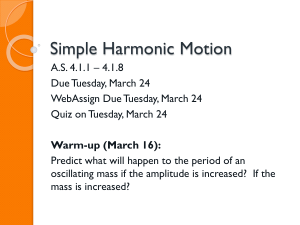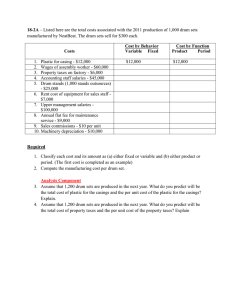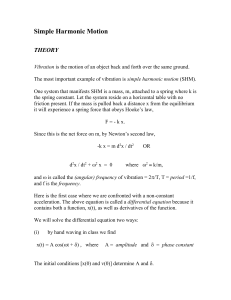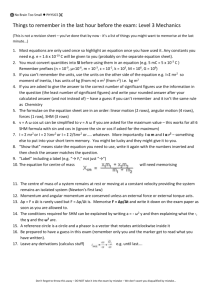Document 11647635
advertisement
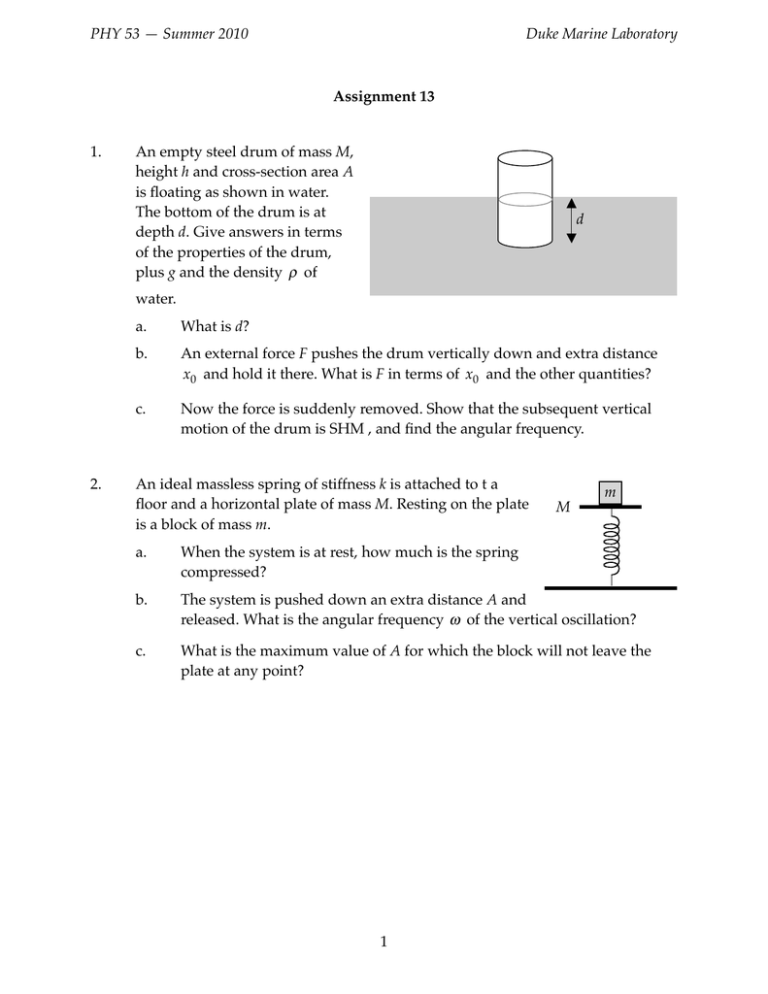
Supplementary Problems for Topics III PHY 53 — Summer 2010 1. 1. Duke Marine Laboratory An empty steel drum of mass M, height h and cross-section area A is floating in water. The partially submerged as shown Assignment 13 bottom of the drum is at depth d below the surface. Express all answers in terms of the given quantities, g, and the density ! of water. An steel of mass M, a. empty What is drum d? height h and cross-section area A b. Now an external force of is floating as shownFin magnitude is water. exerted The bottom of top the drum at on the of the is drum, d pushing it further down depth d. Give answers in terms into the water an extra of the properties of theby drum, distance x0. Express F in plus g and theof density terms x and ρtheofother 0 water. quantities. c. Proveisthat a. What d? if the external force is suddenly removed the drum will execute simple harmonic motion in vertical oscillations. [How does the net force depend on the vertical displacement x of the drum equilibrium b. An external force F pushes the drum vertically downfrom and its extra distance position?] x0 and hold it there. What is F in terms of x0 and the other quantities? d. Find the angular frequency of those oscillations. c. Now the force is suddenly removed. Show that the subsequent vertical motion of the drum is SHM , and find the angular frequency. 2. 2. An aspirator is a device that mixes small amounts of a fluid (such as liquid fertilizer) with water, so of that it can be over is such a An ideal massless spring stiffness k issprayed attached to taalarge area. Shown m device. from a plate hose (on the left) flows through a constriction, where a floor andWater a horizontal of mass M. Resting on the plate M vertical tube introduces the fluid is(at a block of mass m. negligible speed) into the rapid v0 a A water flow. The height through a. When the system is at rest, how much is the spring which the fluid must rise is h as h compressed? shown. If the fluid-water mixture exits into air atisspeed v0, down what an extra distance A and b. Thethe system pushed must be the minimum ratio A/a of frequency ω of the vertical oscillation? released. What is the angular the cross-section areas of the two regions? Assume fluid and c. What is the the maximum value of A for which the block will not leave the water plate have at theany same density !. point? [Find the water pressure in the constriction.] 1 PHY 53 — Summer 2010 3. Duke Marine Laboratory Questions about oscillations that are not quite simple harmonic. a. We have been assuming the springs in our examples have no mass. If we took into account the mass of an actual spring attached to a mass m and oscillating, would the real value of ω be larger or smaller than the one we get from ω = k /m ? Explain. b. The oscillations of a simple pendulum are SHM in the approximation that cosθ ≈ 1 − θ 2 / 2 , where θ is the angle made by the string with the vertical. The approximation for the cosine is more exact if we keep the next term in the series, so cosθ ≈ 1 − θ 2 / 2 + θ 4 /12 . Would this make ω larger or smaller than 4. g / ? A block of mass m is attached as shown to a horizontal spring, which is attached to a wall. The block is oscillating on the frictionless floor with amplitude A0 and maximum speed v0 . At the instant when the block is at its furthest to the right, momentarily at rest, it is struck by a second identical block, moving to the left at speed v0 , and the two block stick together after the brief collision. a. What is the ratio ω /ω 0 of the angular frequencies of oscillation after and before the collision? b. What is the ratio A/ A0 of the amplitudes after and before the collision? c. What is the ratio v / v0 of the maximum speeds after and before the collision? 2 PHY 53 — Summer 2010 6. Duke Marine Laboratory A spring of stiffness k is attached to a wall and to the axle of a wheel of mass m, radius R, and moment of inertia I = β mR 2 about the axle. The spring is • stretched distance A and the wheel is released from rest. The floor has sufficient static friction that the wheel rolls without slipping. a. When the spring is stretched distance x and the wheel’s CM has speed v, what is the total energy of the system? Ans: 12 m(1 + β )v 2 + 12 kx 2 . b. 2 What is the maximum speed of the CM? Ans: vmax = c. Show that the motion is SHM and find the angular frequency ω . [One kA 2 m(1 + β ) way: use dE/dt = 0 , where E is the total energy, and show that a = −(const) ⋅ x , where the constant must be ω 2 .] Ans: ω 2 = k /m(1 + β ) . 7. A small mass sliding without friction on a circular track executes the same motion as the bob of a simple pendulum, the normal force from the track replacing the tension in the string. So it is only approximately SHM for small oscillations near the bottom of the track. But it is possible to design a track in which the mass will execute SHM for large amplitudes. The shape that works is part of a cycloid, a curve given in parametric form by Here t can be thought of as like the time, and these equations give the trajectory. You are to show that this track gives SHM, and to find the angular frequency. a. x = R(t + sin t), y = R(1 − cost) . We need to convert from x and y to the arc length variable s that gives the distance along the track from the bottom. The formula from calculus is 2 2 2 ⎛ dy ⎞ ⎛ ds ⎞ ⎛ dx ⎞ ⎜⎝ dt ⎟⎠ = ⎜⎝ dt ⎟⎠ + ⎜⎝ dt ⎟⎠ . Carry out the derivatives to find ds/dt as a function of t. b. Integrate to find s(t) , choosing s = 0 when t = 0 . c. Use the identity sin 2 (θ / 2) = 12 (1 − cosθ ) to relate s 2 to y. d. The potential energy is mgy , of course. Write this in terms of s to show the motion is exactly SHM and read off the value of ω . 3 PHY 53 — Summer 2010 8. Duke Marine Laboratory Two blocks, of mass m and 2m, are resting on a frictionless table, attached as shown to an ideal spring of stiffness k. A third block, of mass m, moving to the right with speed v0 as shown, collides with and sticks to the other block of mass m. The combined system then moves to the right. [Give all answers in terms of m, k, and v0 .] a. Describe the subsequent motion of the system. b. What is the total kinetic energy just after the collision, when the block of mass 2m has not yet started to move? [What is conserved in the collision?] Ans: 14 mv02 . c. What is the kinetic energy at an instant when all the blocks are traveling with the same speed? [This is the kinetic energy of the CM motion alone.] Ans: 18 mv02 . d. The instant in (c) is when the compression or extension of the spring is its maximum amount xmax . What is xmax ? Ans: (v0 / 2) ⋅ m/ k . 9. Two mass-spring systems, A and B, are attached to a flexible horizontal rod as shown. When A is set into oscillation with its natural frequency ω 0 , A B the rod begins to vibrate slightly up and down at that frequency. This vibration acts as a driving force for B. We are interested in the average power of the driven oscillation of B, in two cases: (1) B’s natural frequency is ω 0 ; (2) B’s natural frequency is 2ω 0 . Assume A is undamped. a. Let B have damping such that b/m = ω 0 . What is the ratio of the average power delivered to B in the two cases? Ans: 17/4. b. Repeat for the case where b/m = ω 0 /10 . Ans: 226. c. In case (1) let both systems be undamped. Discuss the energy transfer between the systems over time. (Total energy is conserved.) [See the notes on Oscillations, page 7.] 4
